The sewerage or drainage system in a private house is developed at the stage of its design and planning. This is one of the most important communications. Its installation is quite strictly regulated by the norms and rules of arrangement, preserving measures for cleaning and protecting the environment. One of the simplest and most affordable sewerage options for a private house is a drain or cesspool. Despite the primitive design, its device has a lot of nuances that must be taken into account.
Sanitary standards and the rules (SanPiN and SNiP) for this type of buildings were not developed by chance. They have been operating on the territory of Russia since the times of the Soviet Union. Even then, it was noticed that the absence of any rules for arranging a drainage pit, with a certain density of residential buildings, and a small distance between them, it can cause serious damage not only to the environment, but also to people living in this zone. After carrying out a number of studies in this area, the peculiarity of wastewater seeping into the ground was noticed, reaching the upper threshold of groundwater. The result was uncontrolled contamination at long years, the consequences of which were felt on soil fertility and the quality of the region's water resources.
Certain difficulties are caused by the secrecy of the building, the very presence of which and the quality of the construction works by its arrangement it is often extremely difficult to determine. However, the harm is primarily felt by the owner, who violates the standards and rules for the manufacture of a drainage pit, as well as neighbors living in neighboring areas. Therefore, when designing a plot of a private house, the construction of a drain pit must be carefully studied, thought over and not too lazy to coordinate sanitary standards with the local SES, in order to avoid mistakes and violations that could entail irreversible consequences for the ecology of the site.
Compliance with the rules of placement and protection of internal space cesspool, on the contrary, it is completely legal and permissible, especially since in some cases this is the only rational way to arrange a sewage system on a section of a private house.
![]()
What are the drain pits
Structurally, drain pits can be divided into several main categories:
- With soil post-treatment;
- Sealed (with storage).
To begin with, it is worth noting what is a violation in such a device technical regulations and regulations. And first of all, this is the absence of any protection at the bottom and walls of the cesspool. The runoff, getting into its area, freely and without hindrance penetrates into the soil, getting stuck there for many years, upsetting the ecological balance. Some of them are digested by aerobic bacteria. But putrefactive processes continue in the soil, and make it less suitable for agriculture. With a large remoteness of vegetable gardens and neighboring similar structures, the damage from them is less significant and tangible. In the absence of materials for insulation, this method was generally the only one possible for many years. But times have changed. Today, you can easily get any material and equip a modern cesspool without harm to the environment and yourself.
So, in the form of a drain pit, you can equip it as follows:

Rules and regulations of SNiP and SanPiN for the arrangement of cesspools in personal and summer cottages
Having decided on the type of cesspool, it is necessary to calculate its location on the site. For this, there are restrictive recommendations of the following documents:
- SanPiN 42-128-4690-88 "Sanitary rules for maintaining the territories of populated areas";
- The set of rules SP 32.13330.2012 “SNiP 2.04.03-85. Sewerage. External networks and structures ";
- SNiP 30-02-97: "Planning and development of territories of horticultural associations of citizens, buildings and structures."
The remoteness of the drain pit, especially with soil pre-filtration, according to the SNiP standards, should be at a distance:
- From a residential building - 8 - 10 m;
- Household buildings - 5 - 7 m;
- Fence - not less than 1 m;
- Neighboring house - 10 - 12 m;
- Water intake wells - 20 - 30 m;
- Water pipes - 20 - 25 m;
- Gas pipes - 5 m;
- Trees - 5 - 7 m.
 Photo: sanitary standards
Photo: sanitary standards  Photo: the remoteness of the drain pit
Photo: the remoteness of the drain pit Advice!
The type of soil and its properties also matter when laying sewers. Clay soils are dense and oily, they conduct water worse. Cesspools in such soils should be at a distance of at least 20 m from natural wells. For loams, this parameter is already 30 m, for sandy soils - 50 m.
In design work, the sewerage system of a private house must be taken into account in full, since it consists of an internal (located within the house) and an external part (all the rest of the sewerage on the site). A detailed drawing will help to calculate the amount of materials for the sewage system, its location on the site, determine whether it will be gravity-fed or need to be forced, and at what distance from residential and auxiliary buildings in a suburban area.
 Photo: drawing of a drain pit
Photo: drawing of a drain pit For professional plumbers, engineers, designers, solving these problems is not difficult. But even for an ordinary man in the street, these rules of SNiP and SanPiN are not so complicated, because a cesspool is the most primitive, and at the same time, the cheapest sewerage device for summer cottage, which you can do yourself.
A cesspool is the easiest way to dispose of wastewater. This design relevant only for residents of summer cottages and country houses, since the issues of sewage in apartment complexes are solved by special organizations. It should be noted that it is most rational to construct drainage pits in areas with temporary residence, where the volume of wastewater does not exceed 1 cubic meter. This procedure has its own rules and requirements, which are spelled out in SNiP and SanPin. In order to complete the work, we will consider all the nuances and norms of such a sump for your home.
Principle of operation
In most cases, the design consists of two tanks, one is engaged in the separation of effluents, and the second is filtering and settling them. Such a system is connected by a pipe through which the liquid is transported to the compartments. The sewerage pipeline delivers wastewater only to the first container.
If we consider the simplest way, then this option will have only one compartment. This means that such a cesspool will function as a sump. This method of disposal is both simpler and cheaper, but it should be noted that it excludes the possibility of filtering waste. Cesspools without a bottom are beneficial in such conditions, but they are undesirable in sewerage installations, since they are ecologically dangerous. These rules and regulations are described in SNiP and SanPin.
In the case of a single-chamber pit, it is recommended to concreate the bottom. In such a design, sludge of solid particles gradually accumulates, which can then be pumped out. In addition, there are various biological agents that are capable of filtering sewage fluid. Their use in the system will reduce the number of calls to sewers. It is worth highlighting the following advantages of such a building:
- Independence from soil type and surface water level;
- Simplicity of construction;
- Does not have specific rules and regulations for operation;
- Environmentally friendly system.
Pit arrangement
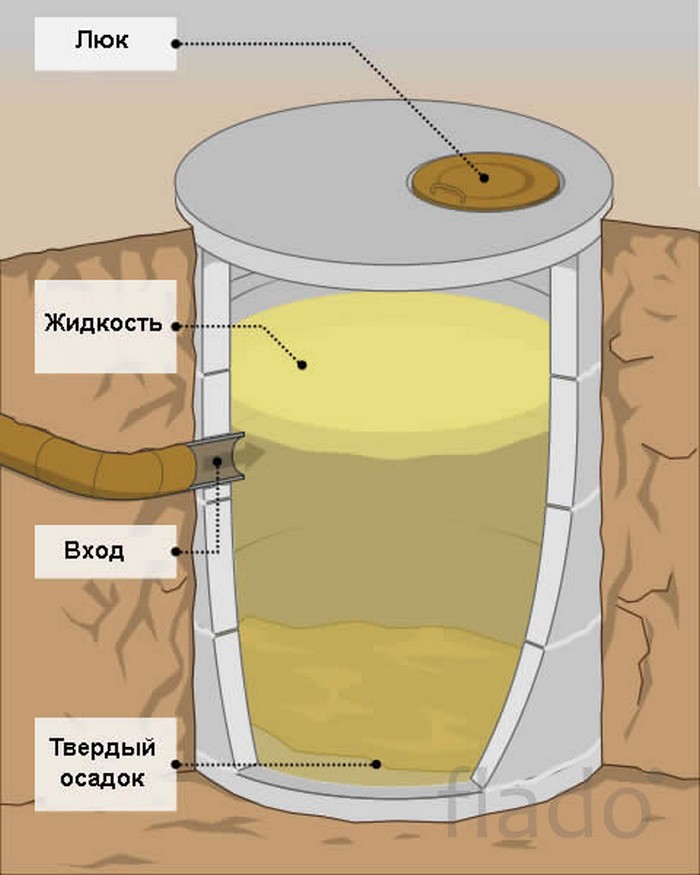
Today there are many projects for optimization sewerage system in a private house or cottage. In this section, we will look at the rules and regulations for arranging holes. Runoff from the sewerage system of the site flows into a sump, where over time they accumulate and require pumping.
Important! Installing a drive without a bottom is prohibited according to SNiP. The safest cesspool is considered to be concrete rings with bottom and lid.
In order to build an optimal sewage disposal system, we must know all the rules and sanitary requirements for SNiP and SanPin for the location and structure of the structure. Today, there are such norms for the implementation of the process:
- The supply pipe must be placed closer to the hatch - this will make it possible to fully exploit the volume of the sump;
- The distance from the base to the soil surface should be 3 meters;
- When building a structure, it is permissible to use a monolith, concrete rings, bricks;
- Hydro- and thermal insulation of the container must be carried out;
- The drain hole can be enlarged if necessary. To do this, it will be possible to add a second tank to the design.
- A special float is used to determine the level of effluents;
- According to sanitary requirements, the cesspool must have a ventilation system;
Important! The most important rule is the arrangement of an entrance for specialized equipment.
Code of practice for location

When building a sump on a small-sized house or summer cottage, the rules and regulations are slightly simplified. If you permanently live in the house, but do not use expensive household appliances, then your needs will be satisfied and drain pit... Such a device can easily cope with the daily volume of wastewater up to a cube of liquid.
SanPin sanitary standards oblige to fulfill certain requirements for the location of the sump on the site of the house or summer cottage. Based on them, the distance to the house should be more than 5 meters.
Important! If the volume of wastewater exceeds 8 cubic meters, then the distance from the house should be 8 meters.
What should be the distance from objects for a sealed structure? The SNIP provides for the following requirements for the nuances, location of the sewage disposal system of the site:
- Cesspools in an autonomous structure with a volume of 3 cubic meters, should have a distance of 40 meters from the drinking water pipeline;
- A drainage pit should be located from the pipeline downstream of the groundwater at a distance of 25 meters;
- In the event that the cesspool is in the form of a perpendicular location to the groundwater, then the distance to the sewer must be 25 meters;
- The well and the well can be no closer than 20 meters from the pit.
Attention! Experts advise performing the installation downstream of the water flow on the site, and the well, on the contrary, upstream of the ground streams.
Sanitary requirements for location
Very often, when performing construction work, certain sanitary standards are not met. In some cases, a cesspool on a private plot has the right to break them. Experts advise to resort to such practices as solving certain problems with neighbors. For example, wells are installed in the same order, which will facilitate calculations of the settling tank location.
The most important requirements on a private site are compliance with the parameters of a special paved site. It should be at a slope of 5 percent, measuring 3 by 2.5 meters. It should be noted that its distance from the red line must exceed 2.5 meters. In the case when the drain pit is being done with your own hands, it will be more rational than all norms, because this will help prevent various accidents in a private area.
Cesspools - options and types of device
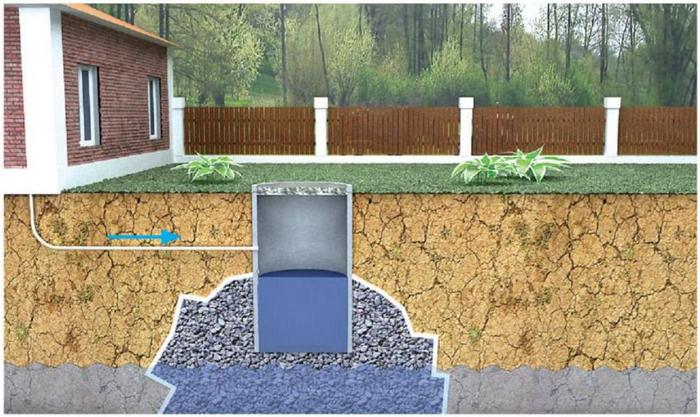
To date, in practice, you can find two options for arranging the sewage system in a private area. These are such types as:
- Drain pit;
- Engineering system.
Also, it is worth noting that these sewage disposal structures have a large number of branches in the classification, but we will consider the largest division. So, the drain pits are divided into the following groups:
- Bottomless devices;
- Sealed sedimentation tanks.
Let's consider the features of each of them in more detail.
Cesspool without a bottom
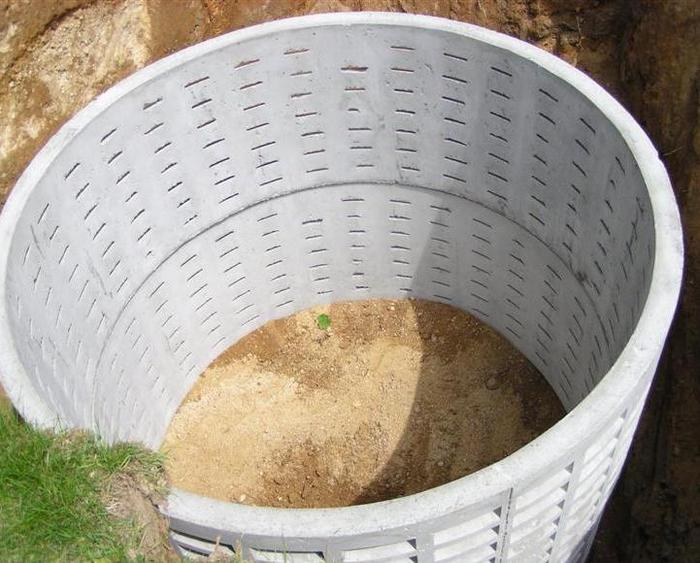
One of the most elementary device options on the site is a cesspool without a bottom. This view It is rational to use sedimentation tanks in houses where the daily consumption does not exceed one cubic meter. According to sanitary standards, the boundaries of this device must pass below the water intake level at the site.
The drain pit must be installed according to the required parameters, so we need to find out. Basically, these requirements relate to the soil and the location of the sump from other objects. So, a do-it-yourself drain pit is installed according to the following rules:
- In case of placement on a site of clayey soils, the distance to the well should be more than 20 meters;
- With loamy soil - 30 meters;
- The sandy soil cover of the earth requires a distance to the place of water intake of more than 50 meters.
Attention! A drain pit without a bottom is not appropriate in the case of a waste volume of more than a cube. In such a situation, it is recommended to install sealed sedimentation tanks.
Sealed cesspools
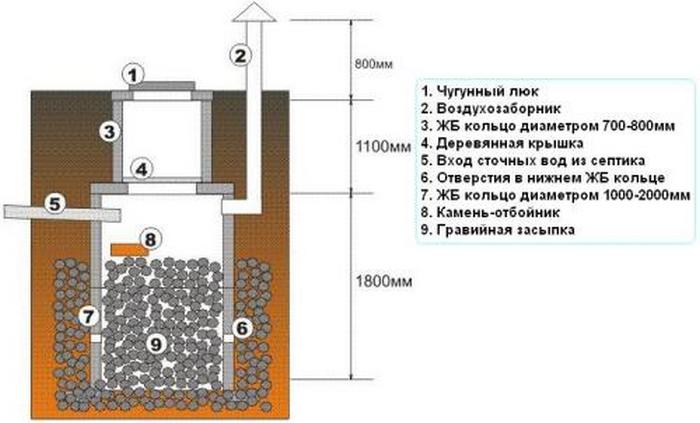
These devices have a number of their own characteristics. They manifest themselves in various parameters such as:
- Construction, the bottom of which slopes towards the hatch intended for cleaning;
- The choice of a place that has the following indications: 10 meters from the house, 1 meter from the fence;
- Periodic cleaning of the system, which is carried out by special machines of specialists.
Attention! It is desirable that the installation depth does not exceed 3 meters. If the drain pit is located below, then this will exclude the possibility of pumping out by suction trucks.
To prevent the accumulation of gas that can explode, ventilation must be provided. According to building codes, the diameter of its pipe should be 10 cm and rise 1 meter above ground level. It should be noted that the drainage system is just as important as ventilation, because without them it is impossible to use a hermetic sump.
To equip the sewage system in a summer cottage or city site, you need to follow not only construction, but also legislative standards. Cesspool: the rules and regulations for its arrangement are observed especially carefully. Violation of sanitary and construction requirements entails administrative and, in some cases, criminal liability.
One of the basic laws on which most of the norms and requirements of SanPin are based is the federal law No. 52-FZ ("On the sanitary and epidemiological well-being of the population" dated March 30, 1999 ").
SanPin regulates the strictest volumes of cesspools. The design of the drain tank depends on the average daily amount of wastewater. Structurally, pits are:
AT SanPiN 42-128-4690-88 indicates the sanitary standards to ensure the well-being of the population. They say that if the total volume of wastewater does not exceed 1 cubic meter per day, then an open pit arrangement is permissible. If there are more drains, then a filtering or sealed bottom must be equipped. It should be noted that complete lack of protection is also not permitted in open pits.
SanPin standards describe in sufficient detail the requirements for the protection of groundwater. These requirements are filed in the regulation SP 2.1.5.1059-01 of 2001. Particular attention is paid to the design of the bottom of the pit. Sanitary organizations require the arrangement of the filter bottom, which consists of:
- Sand cushion;
- Crushed stone pillow;
- The stone layer in which is used construction Materials different factions.
It is emphasized that if more than 4 adults live in the house and household appliances are installed connected to the sewage system, then a multi-chamber pit or septic tank must be constructed. These are reservoirs with a higher degree of protection against pollution of the environment with waste toxins.

The rules and regulations for arranging a cesspool in Ukraine are somewhat different from Russian ones. According to Ukrainian legislation, the cesspool can be performed exclusively closed type made of durable, waterproof material. In any other case, you will not be able to legalize it and are subject to fines, up to a court order to remove the tank from the site.
Location selection
Sanitary organizations strictly monitor the distance from the cesspool to the facade of residential and non-residential premises, as well as wells and other reservoirs on the site. Special norms have been developed, which indicate the standard requirements. They are spelled out in the Sanitary Rules for the Maintenance of Populated Areas No. 42-128-4690-88 and SNiP 30-02-97:
- Minimum allowable distance from the facade of a residential building - 15 meters. Please note that if the basement exceeds the building area, then the countdown is from the basement wall;
- From non-residential premises and buildings located on another site, 10 meters or more (if possible) must be maintained. If these norms are not met, then the owner of the neighboring plot has the right to sue. Penalties are provided as punishment;
- If there is a well or a well on the site, then a distance of 20 meters is maintained from them. Here, the norms differ, since the footage depends on the level of groundwater. The higher it is, the greater the distance. If the terrain is swampy, then the cesspool is not allowed to equip. At the same time, on the sand, the minimum permissible distance is 50 meters. This is due to the large throughput sand;
- From the road, the fence should be at least 1 meter.

Regardless of the distance, before starting the preparation of the pit, its depth is calculated. The lower border of the pit should be 50% below the drinking level ground water... This information can be obtained from your local geological organization.
![]()
Here:
- 1 - top layer of soil (black earth);
- 2 - crushed stone filling of the pit for compaction;
- 3 - drains;
- 4 - crushed stone pillow at the bottom of the pit.
Good neighborliness
This concept characterizes the legal relationship between neighbors. According to legislative acts, the owner of the site can organize any buildings on his land. But, at the same time, he must take into account the safety of the people around him.
An incorrectly chosen location of the cesspool can bring a lot of inconvenience to both its owners and its neighbors. Of the most common problems:
- Destruction of the foundation. The waste tank not only contaminates the soil and water, but also increases the moisture level of the soil. In this case, the foundation begins to collapse over the entire area. This is fraught with cracks in the walls, deformation of the structure and even its destruction;
- Bad smell. Many believe that it is necessary to maintain a distance of only 20 meters from the facade of your house, and not from a neighbor's. Naturally, a stench will emanate from the reservoir, which, first of all, will disturb those who live closer to it. The smell not only interferes with a normal life, but also harms health;
- Infection of the land and a decrease in its yield. Not only buildings suffer, but also garden plantings. Many fruit trees, ornamental plants and vegetable crops die from change chemical composition soil. This entails a certain financial liability on the owner of the cesspool.
All the requirements and norms described above are mandatory for both private homeowners and individual entrepreneurs, as well as legal entities.
SanPin: operation of the cesspool
The rules and regulations for cesspools also specify certain standards for the care of drains. Regardless of the type of cesspool, it must be cleaned 2 times a year with sterilizing mixtures. This is done after the sewer cleaning, so that it is possible for some to completely neutralize the action of pathogenic bacteria.
For sterilization, a special acid-based chemical solution, gentle compounds or homemade mixtures are used. It is strictly forbidden to use pure chloride of lime. When mixed with water or other chemicals, it gives off dangerous gas. It is odorless, but it can cause severe poisoning and burns of the upper respiratory tract.

For home self-service, a mixture is used, which includes:
- Bleaching powder;
- Creolin;
- Naphthazole and some other compounds.
Every two weeks, cleaning is required, and every season an inspection of the cesspool. The pit can be cleaned independently, using a sewage machine or cleaned with bioactivators.
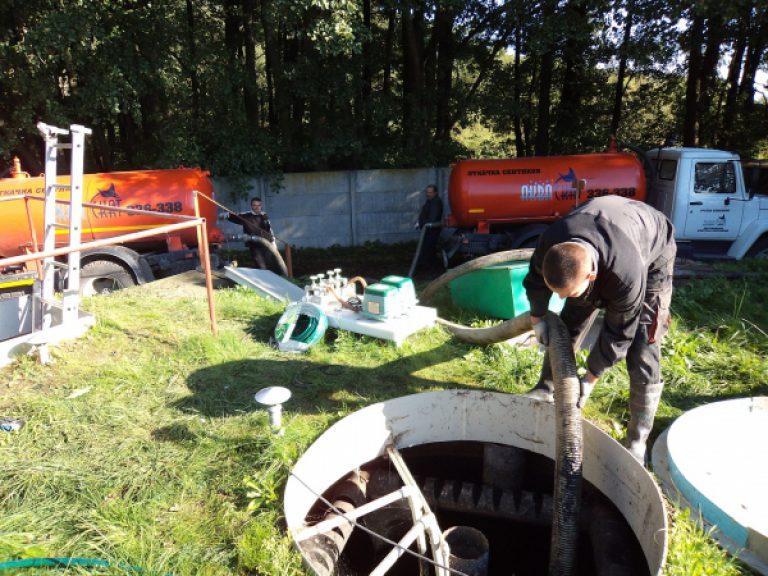
Many owners of private houses today refuse to connect to centralized engineering lines. In particular, the best option is to equip an autonomous cleaning system or a simpler and cheaper cesspool. So that this approach really gives an effective result in terms of smooth operation and savings with financial side in the process of servicing the tank, and also did not bring discomfort to life, it is imperative to follow the rules for the placement and construction of a cesspool. You will familiarize yourself with them in this article.
Before proceeding with registration autonomous sewerage, first of all decide on optimal size pits based on the following standard norms:

Types of cesspools
To date, there are 2 options for the design of the cesspool:

Standards for the construction of a cesspool without a bottom
Such a construction is the simplest way creation of a structure for household waste, provided for by the SNiP norms for cesspools. According to the established rules, such a drainage ditch must be built in compliance with the following conditions, which relate mainly to the relative position of a cesspool and a well with drinking water:

Requirements and standards of a sealed cesspool
Such a cesspool is a one-piece wastewater reservoir, for the creation of which concrete, brick, metal, as well as special plastic forms of a suitable size are used. Such a treatment facility should provide:
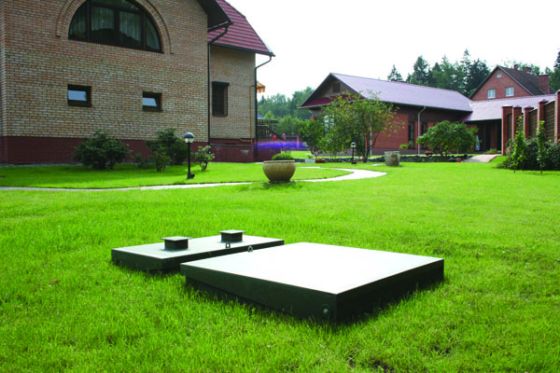
Design features:
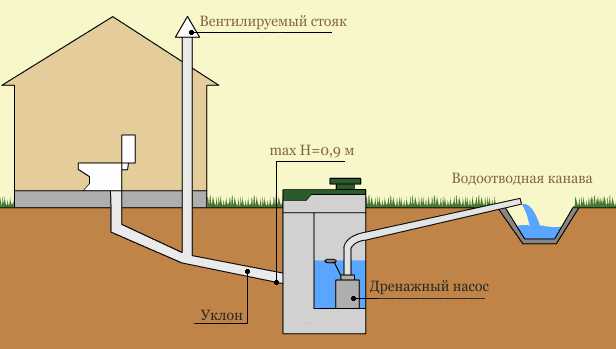
Sump placement rates
When choosing a location for a wastewater well and associated treatment facilities, adhere to the following requirements:
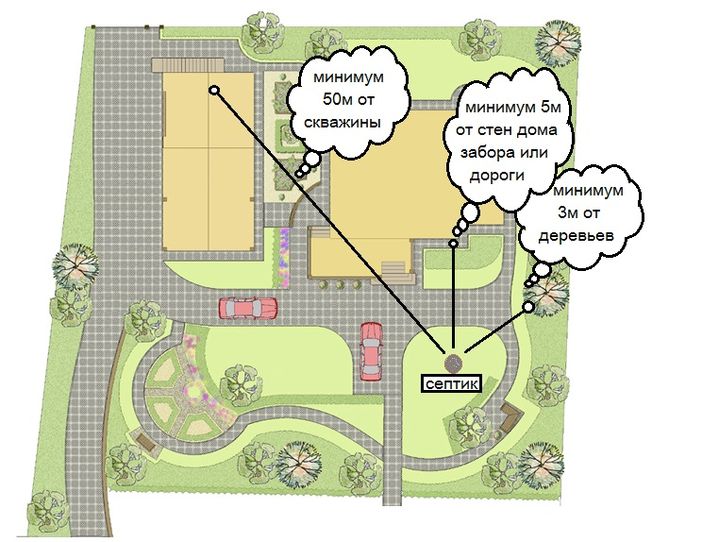
Sump placement standards relative to other engineering systems
A few more norms for placing a cesspool directly relate to the lines of other communications - gas and water supply:

Cesspool cleaning rules
The whole process of arranging a cesspool is not particularly difficult and does not require significant costs. More effort will have to be made in the process of servicing it, since self-cleaning in this case does not occur, regardless of whether it is a pit without a bottom or a sealed drive. For timely disposal of waste water optimal solution there will be an order for a sewage truck with specialists who will quickly remove all waste. It is recommended to carry out such a procedure, in the absence of emergencies or failures in the operation of the system, twice a year. 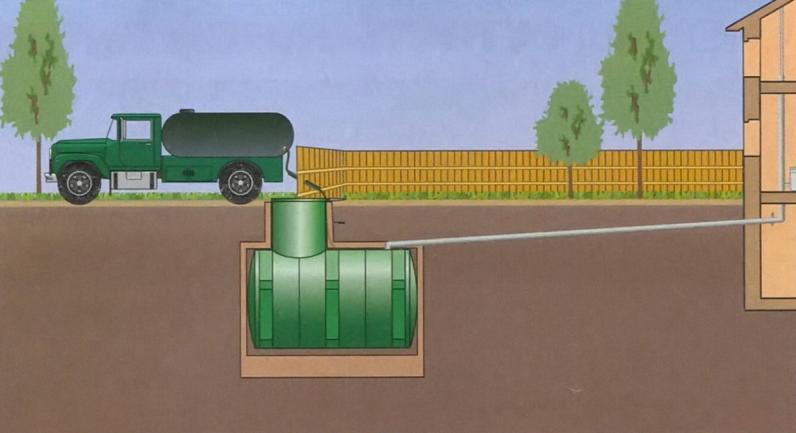
In addition to cleaning the cesspool, disinfection is also required. A solution of the following components is suitable for this procedure:

Conclusion
A reliable sewerage system on your own site is a guarantee of a safe stay in the house and easy decoration of a beautiful landscape area. To make a designed autonomous cesspool a truly profitable solution, be sure to adhere to all of the above rules during the creation process. This approach will reduce the risk of a threat to your health, as well as eliminate the waste of accumulated funds.
Unfortunately, not all private houses located in rural and urban settlements are covered by the network of urban communications. In many areas, there is still no central communications network. Many owners are forced to resolve this issue on their own. Therefore, this article is aimed at those readers who are interested in the topic "cesspool + construction standards and rules of arrangement".
Drive placement standards
The same distance is observed when planting fruit plantations. Failure to comply with these rules can lead to the appearance of pathogens in water and fruits and in the future to the development of ep. "Width \u003d" 640 "allowfullscreen \u003d" "frameborder \u003d" 0 "\u003e
Therefore, for such a number of people living in the house, a 3x2 meter storage drive should be built.
No less important than the choice of the location and size of the cesspool is the calculation of the need for the amount of building materials.
Proceed from the fact that it is necessary to concrete the bottom, cast or build walls, concrete the floor and build a hatch.
As with any construction, you should prepare the construction site, clear the area of \u200b\u200bplantings, make markings, and dig a hole.
The bottom is carefully compacted and filled with concrete. After it acquires 80% strength, you can start laying out the walls.
Joint seams concrete wells or brickwork when erecting the walls of the pit, they must be properly sealed in order to avoid the ingress of wastewater into the groundwater.
Only a sealed cesspool can become a guarantee of the reliability of this sewer structure in operational and environmental terms.
Always the stage of construction should be preceded by the stage of carrying out geodetic works, which helps to determine the proximity of the occurrence of groundwater and, directly, the possibility of placing a cesspool on a specific site.
Designing a cesspool on a personal plot makes it possible to equip a local toilet without a central sewerage system.
To do this, you need to install a toilet for the cesspool. It is preferable to choose the type of toilet with an inclined visor.
Before installing it, a drain is arranged in the ceiling: the discharge pipe is lowered into the storage tank by 40 cm at an angle of more than 40 degrees.
For this, ceramic, steel and cast iron pipes diameter 15 cm. All seams are insulated.
Combining a toilet and a cesspool is a more rational solution in arranging a toilet near a private house.
The connection of pipes from the internal sewage system of the house is carried out according to the rules:
- it is necessary to observe the depth and inclination of the outlet pipes;
- take into account the presence of an inspection well.
At the time of excavation of a trench for laying outlet pipes, you can find pipes for other purposes. In this case, your actions for the further arrangement of the cesspool should be coordinated with the relevant authorities.
Optimal drive cleaning
The cesspool is easily and quickly set up, without the use of costly methods. Its disadvantages include the impossibility of self-cleaning.
Optimal wastewater treatment is carried out using a sewage machine by immersion in a pit through a special intake hose hatch. Therefore, it is important to design the bottom of the storage tank with a slope relative to the pit.
It should be noted that according to SNIP, the cesspool should be located below the water intake wells at a distance of 30 meters from them.
The same distance is observed when planting fruit plantations. Failure to comply with these rules can lead to the appearance of pathogens in the water and fruits and in the future to the development of an epidemic.



